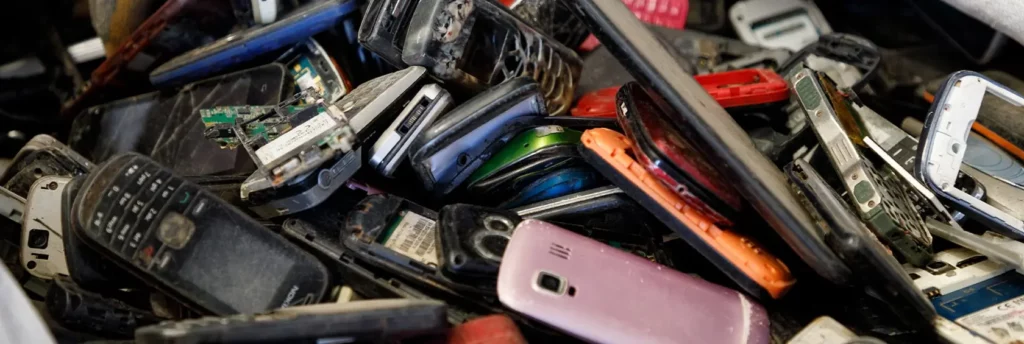
What does e-waste neutral mean?
For some reason, people love hoarding old electronics. Having worked in the industry for four years and coordinated Fairphone’s circularity efforts since 2020, the amount of friends and colleagues who confirm they have a stash of old phones, cables, and MP3 players hidden away in some drawer baffles me. Here in Europe, we separate our empty plastic yogurt pot from its cardboard wrapper before putting it in the bin – but most of us still shy away from giving the gold, silver and other materials in our electronics a second life, be it out of convenience or the fear of “doing it wrong”. It is estimated that globally, around five billion phones are simply abandoned in drawers and boxes. But why should the burden be (just) on the consumer? As the Fairphone’s resident Circular Material Chains Innovator, I believe it is high time manufacturers started truly taking responsibility for all the stuff they put on the market. At Fairphone, we are always happy to share our research results and insights with anyone who is interested.
It is estimated that globally, around five billion phones are simply abandoned in drawers and boxes. © 2024 Closing the Loop
Here’s the problem: There are over 40 different materials inside a smartphone, each with its own, complex supply chain. By recycling our devices, we can only recover a handful of these materials and around 30% of the weight of these resources – which is why the main focus should always be on repairing and on using what still works. Yet by leaving our gadgets to rot in that drawer, we recover nothing at all.
Even just looking at the devices that are actually disposed of, electronic waste – or e-waste – is the fastest growing waste stream on earth, and it is expected to nearly double until 2030. For a whooping 83% of these electronics, we do not even know what happens to them once they are no longer in use – only that they are never documented as having been responsibly recycled.
When you look at Fairphone’s product portfolio, you will find that all our recent products are “electronic waste neutral”. That doesn’t mean they will never end up in a landfill in the distant future. It also does not mean that every Fairphone on this planet gets reused or recycled – though I would definitely love to get us there one day.
Instead, we try to do our part by collecting one phone for one phone or summing up the weight of new devices and spare parts we sell and making sure that the equivalent amount of existing electronics get reused or recycled, with a clear preference for re-use. We try to keep this as tangible as possible and focus on engaging consumers and businesses in our own market – which sounds probably easier than it is. For instance, we ask people to send in their old phones when they buy a Fairphone, in return for a gift voucher. I personally attended one of the “E-Waste Races” we are sponsoring at schools, motivating kids to collect waste and learn about recycling in a fun way. We also organize urban mining workshops at companies such as Heineken here in the Netherlands, handing employees safety goggles and a tool kit and using broken phones to educate them about rare materials and the right to repair. We work together with partners in Africa to collect waste from places where a lot of European used products and, illegally, e-waste end up, but that often lack environmentally and socially sound recycling infrastructure. With every phone that is properly recycled, we not only preserve valuable resources, but also avoid the negative health and environmental consequences that come with e-waste which is not treated appropriately.
With every phone that is properly recycled, we not only preserve valuable resources, but also avoid negative health and environmental consequences. © 2024 Closing the Loop
By combining all these efforts, we collected 9.6 metric tons of electronic waste in 2022, 37% of them coming from that EU market that we actually sell our products on. That equals 100% of our ‘electronic waste neutral’ product sales, either in weight or 1 device for 1 device. And while the recovered materials may not directly end up in Fairphone’s factories, we are constantly working to increase the proportion of recycled materials used to make our new phones.
Don’t get me wrong: electronic waste neutral is not the one-size-fits-all panacea to all the problems in this industry. Ultimately, the safest way to preserve materials at their highest level of quality is to produce fewer new devices and use what we already have. In fact, our research proves that devices that are easier to repair are usually easier to recycle, too! But keeping in mind the perennial discount marathons, I would like to remind our industry peers that our responsibility for the products we make does not end at the check-out counter. Electronic waste neutral is only a part of the solution – but I am proud of every device that, as a consequence of our efforts, has already left that dusty drawer and been given a second life.
Share this post
The post you are currently reading is an AMP HTML document; an optimized version for mobile usage to increase loading speed and decrease data usage. To see our full website you can visit our own mobile version of this post.